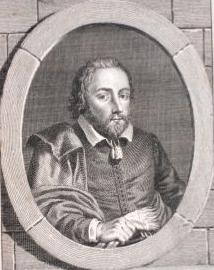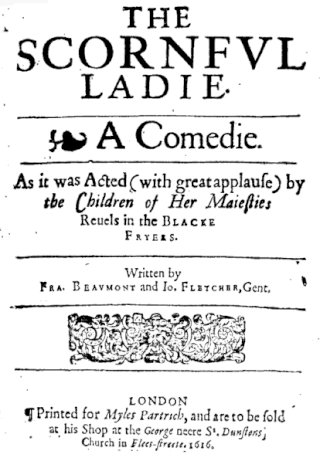The first folio, 1647
The 1647 folio was published by the booksellers Humphrey Moseley and Humphrey Robinson. It was modelled on the precedents of the first two folio collections of Shakespeare's plays, published in 1623 and 1632, and the first two folios of the works of Ben Jonson of 1616 and 1640–1. The title of the book was given as Comedies and Tragedies Written by Francis Beaumont and John Fletcher Gentlemen, though the prefatory matter in the folio recognised that Philip Massinger, rather than Francis Beaumont, collaborated with Fletcher on some of the plays included in the volume. (In fact, the 1647 volume "contained almost nothing of Beaumont's" work.) [1] Seventeen works in Fletcher's canon that had already been published prior to 1647, and the rights to these plays belonged to the stationers who had issued those volumes; Robinson and Moseley therefore concentrated on the previously unpublished plays in the Fletcher canon.
Most of these plays had been acted onstage by the King's Men, the troupe of actors for whom Fletcher had functioned as house dramatist for most of his career. The folio featured a dedication to Philip Herbert, 4th Earl of Pembroke, signed by ten of the King's Men – John Lowin, Joseph Taylor, Richard Robinson, Robert Benfield, Eliard Swanston, Thomas Pollard, Hugh Clark, William Allen, Stephen Hammerton, and Theophilus Bird – all idled by the closing of the theatres in 1642. It also contained two addresses to the reader, by James Shirley and by Moseley, and 37 commendatory poems, long and short, by figures famous and obscure, including Shirley, Ben Jonson, [2] Richard Lovelace, Robert Herrick, Richard Brome, Jasper Mayne, Thomas Stanley, and Sir Aston Cockayne.
The 1647 folio contains 35 works – 34 plays and 1 masque.
The 1647 folio has attracted significant attention from scholars and bibliographers, and various specialised studies of the folio (books on the book) have been written. [3] As with Shakespeare's First Folio, the typesetting of individual compositors and the work of individual printers has been traced and analysed – including that of Susan Islip, one of the rare instances of a female printer in the 17th century.
The second folio, 1679
The second folio, titled Fifty Comedies and Tragedies, was published by the booksellers Henry Herringman, [4] John Martyn, and Richard Marriot; the printing was done by J. Macock. The three stationers had obtained the rights to previously-published works, [5] and added 18 dramas to the 35 of the first folio, for a total of 53. The second folio added features that the first lacked. Many songs in the plays were given in full. Cast lists were prefixed to 25 of the dramas, lists that provide the names of the leading actors in the original productions of the plays. These lists can be informative on the companies involved and the dates of first productions; the cast list prefixed to The Honest Man's Fortune, for example, reveals that the play was originally staged by the Lady Elizabeth's Men in the 1612–13 period.
On the negative side, the texts in the second folio were set into type from the previously-printed quarto texts, and never from manuscript; the texts of the plays in the first collection were printed from manuscript sources. [6]
Content, authorship, and canon
The implicit canon, nearly realized by the contents of the second folio, comprises dramatic works written by Beaumont or Fletcher; either alone, together, or in collaboration with other playwrights. By this rule, likely, four plays should be excluded (The Laws of Candy by John Ford, Wit at Several Weapons by Middleton and Rowley, The Nice Valour by Middleton, and The Coronation by James Shirley), and three more extant plays should be included (John van Olden Barnavelt, A Very Woman, and Henry VIII). A Very Woman was printed in a volume of Massinger's plays in 1655, while John van Olden Barnavelt remained in manuscript until the 19th century. Henry VIII was first published in the Shakespeare First Folio of 1623.
At least five plays, no longer extant, may also belong in the canon. Four of these were entered to Moseley in the Stationers' Register between 1653 and 1660, possibly with the intent of printing them in the second folio: Cardenio (Shakespeare and Fletcher?), A Right Woman (Beaumont and Fletcher?), The Wandering Lovers (Fletcher?), and The Jeweler of Amsterdam (Fletcher, Field, and Massinger?). A fifth non-extant play, The Queen was questionably attributed to Fletcher by a contemporary. [7]
The folios contain two works that are generally thought to be the work of Beaumont alone – The Knight of the Burning Pestle and The Masque of the Inner Temple and Gray's Inn – and fifteen that are solo efforts by Fletcher, and perhaps a dozen that are actual Beaumont/Fletcher collaborations. The rest are Fletcher's collaborations with Massinger and other writers.
- Notes
- 1st Act — Year the play was first acted. Dates are approximate and, unless otherwise noted, follow Gurr. [8]
- 1st Pub — Year of first publication as given by Glover & Waller, unless otherwise noted. [9]
- Authorial attributions — Though there is general consensus, scholars still debate the exact contributions of authors. Unless otherwise noted, attributions are those of Cyrus Hoy. [10]

Philip Massinger was an English dramatist. His finely plotted plays, including A New Way to Pay Old Debts, The City Madam, and The Roman Actor, are noted for their satire and realism, and their political and social themes.
Rollo Duke of Normandy, also known as The Bloody Brother, is a play written in collaboration by John Fletcher, Philip Massinger, Ben Jonson and George Chapman. The title character is the historical Viking duke of Normandy, Rollo. Scholars have disputed almost everything about the play; but it was probably written sometime in the 1612–24 era and later revised, perhaps in 1630 or after. In addition to the four writers cited above, the names of Nathan Field and Robert Daborne have been connected with the play by individual scholars.

Francis Beaumont was a dramatist in the English Renaissance theatre, most famous for his collaborations with John Fletcher.

Beaumont and Fletcher were the English dramatists Francis Beaumont and John Fletcher, who collaborated in their writing during the reign of James I (1603–25).

John Fletcher (1579–1625) was a Jacobean playwright. Following William Shakespeare as house playwright for the King's Men, he was among the most prolific and influential dramatists of his day; during his lifetime and in the early Restoration, his fame rivalled Shakespeare's. He collaborated on writing plays with Francis Beaumont, and also with Shakespeare on three plays.
Humphrey Moseley was a prominent London publisher and bookseller in the middle seventeenth century.
Cyrus Henry Hoy was an American literary scholar of the English Renaissance stage who taught at the University of Virginia and Vanderbilt University, and was the John B. Trevor Professor of English at the University of Rochester. He wrote and published on a wide range of topics in English literature, though he is best known for his works on William Shakespeare, Beaumont and Fletcher, and other figures in English Renaissance theatre.
The Sea Voyage is a late Jacobean comedy written by John Fletcher and Philip Massinger. The play is notable for its imitation of Shakespeare's The Tempest.
Cupid's Revenge is a Jacobean tragedy written by Francis Beaumont and John Fletcher. It was a popular success that influenced subsequent works by other authors.

Ben Jonson collected his plays and other writings into a book he titled The Workes of Benjamin Jonson. In 1616 it was printed in London in the form of a folio. Second and third editions of his works were published posthumously in 1640 and 1692.
Henry Herringman (1628–1704) was a prominent London bookseller and publisher in the second half of the 17th century. He is especially noted for his publications in English Renaissance drama and English Restoration drama; he was the first publisher of the works of John Dryden. He conducted his business under the sign of the Blue Anchor in the lower walk of the New Exchange.
The Honest Man's Fortune is a Jacobean era stage play, a tragicomedy written by Nathan Field, John Fletcher, and Philip Massinger. It was apparently the earliest of the works produced by this trio of writers, the others being The Queen of Corinth and The Knight of Malta.

The False One is a late Jacobean stage play by John Fletcher and Philip Massinger, though formerly placed in the Beaumont and Fletcher canon. It was first published in the first Beaumont and Fletcher folio of 1647.
The Lovers' Progress is an early seventeenth-century stage play, a tragicomedy written by John Fletcher and Philip Massinger. As its multiple titles indicate, the play has a complex history and has been a focus of controversy among scholars and critics.
The Elder Brother is an early seventeenth-century English stage play, a comedy written by John Fletcher and Philip Massinger. Apparently dating from 1625, it may have been the last play Fletcher worked on before his August 1625 death.
The Spanish Curate is a late Jacobean era stage play, a comedy written by John Fletcher and Philip Massinger. It premiered on the stage in 1622, and was first published in 1647.
Beggars' Bush is a Jacobean era stage play, a comedy in the canon of John Fletcher and his collaborators that is a focus of dispute among scholars and critics.
Love's Pilgrimage is a Jacobean era stage play, a tragicomedy by Francis Beaumont and John Fletcher. The play is unusual in their canon, in that its opening scene contains material from Ben Jonson's 1629 comedy The New Inn.
The Coxcomb is an early Jacobean era stage play, a comedy written by Francis Beaumont and John Fletcher. It was initially published in the first Beaumont and Fletcher folio of 1647.

The Scornful Lady is a Jacobean era stage play, a comedy written by Francis Beaumont and John Fletcher, and first published in 1616, the year of Beaumont's death. It was one of the pair's most popular, often revived, and frequently reprinted works.






